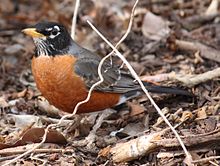- Thrush (bird)
-
- See also other birds with "thrush" in their name: Waterthrush, Shrike-thrush, Thrush Nightingale, Rosy Thrush-tanager
Thrushes 
American Robin, well-known true thrush Scientific classification Kingdom: Animalia Phylum: Chordata Class: Aves Order: Passeriformes Suborder: Passeri Family: Turdidae
Rafinesque, 1815Genera Some 20, see text
The thrushes, family Turdidae, are a group of passerine birds that occur worldwide.
Contents
Characteristics
Thrushes are plump, soft-plumaged, small to medium-sized birds, inhabiting wooded areas, and often feed on the ground or eat small fruit. The smallest thrush may be the Forest Rock-thrush, at 21 g (0.74 oz) and 14.5 cm (5.7 in). However, the shortwings, which have ambigious alliances with both thrushes and Old World flycatchers, can be even smaller. The Lesser Shortwing averages 12 cm (4.7 in). The largest thrush is Blue Whistling-thrush, at 178 g (6.3 oz) and 33 cm (13 in). The Great Thrush is similar in length but less heavily built.[1] Most species are grey or brown in colour, often with speckled underparts.
They are insectivorous, but most species also eat worms, land snails, and fruit. Many species are permanently resident in warm climes, while others migrate to higher latitudes during summer, often over considerable distances.[2]
Thrushes build cup-shaped nests, sometimes lining them with mud. They lay two to five speckled eggs, sometimes laying two or more clutches per year. Both parents help in raising the young.[2]
The songs of some species, including members of the genera Catharus, Myadestes, and Turdus, are considered to be among the most beautiful in the avian world.[3][4]
Taxonomy
The taxonomic treatment of this large family has varied significantly in recent years. Traditionally, the Turdidae included the small Old World species, like the Nightingale and European Robin in the subfamily Saxicolini, but most authorities now place this group in the Old World flycatcher family Muscicapidae.
This article follows the Handbook of the Birds of the World with edits from Clement and Hathaway, Thrushes (2000), and retains the large thrushes in Turdidae. Recent biochemical studies place certain traditional thrush genera (Monticola, Pseudocossyphus, Myiophonus, Brachypteryx, and Alethe) in the Muscicapidae. Conversely the Asian saxicoline genera Grandala and Cochoa belong here among the thrushes.
Genera
FAMILY: TURDIDAE
- Genus Turdus: true thrushes (some 65 species, 1 recently extinct)
- Genus Platycichla: (2 species) - part of a South American group within Turdus
- Genus Nesocichla: Tristan Thrush or Starchy - part of a South American group within Turdus
- Genus Cichlherminia: Forest Thrush - genus paraphyletic with Turdus
- Genus Psophocichla: Groundscraper Thrush
- Genus Zoothera: Asian thrushes (some 22 species, 1 recently extinct)
- Genus Catharus: typical American thrushes and nightingale-thrushes (12 species)
- Genus Hylocichla: Wood Thrush
- Genus Ridgwayia: Aztec Thrush - related to Hylocichla
- Genus Ixoreus: Varied Thrush - related to other New World genera
- Genus Geomalia: Geomalia
- Genus Cataponera: Sulawesi Thrush
- Genus Sialia: bluebirds (3 species)
- Genus Grandala: related to Sialia
- Genus Cichlopsis: Rufous-brown Solitaire - related to Catharus
- Genus Entomodestes: solitaires (2 species) - related to Catharus
- Genus Myadestes: solitaires (10-11 living species, 2-3 recently extinct) (includes formerly recognized genus Phaeornis)
- Genus Neocossyphus: flycatcher thrushes and "ant-thrushes" (4 species) - related to Myadestes
- Genus Cochoa: cochoas (4 species)
- Genus Chlamydochaera: Fruit-hunter - related to Cochoa
- Genus Heteroxenicus: Gould's Shortwing
Now usually considered a distinct family distantly related to Picathartes:- Genus Chaetops: rock-jumpers (2 species)
For other species previously in Turdidae, see Muscicapidae and chats.
References
- ^ Thrushes by Peter Clement. Princeton University Press (2001), ISBN 978-0691088525.
- ^ a b Perrins, C. (1991). Forshaw, Joseph. ed. Encyclopaedia of Animals: Birds. London: Merehurst Press. pp. 186–187. ISBN 1-85391-186-0.
- ^ http://forums.gardenweb.com/forums/load/woodland/msg051859363475.html
- ^ http://rogcad.com/hermitthrush/index.htm
External links
- Thrush videos on the Internet Bird Collection
- High-resolution photo gallery of around 100 species.
- Story on thrush ingenuity

This article about a thrush is a stub. You can help Wikipedia by expanding it.
